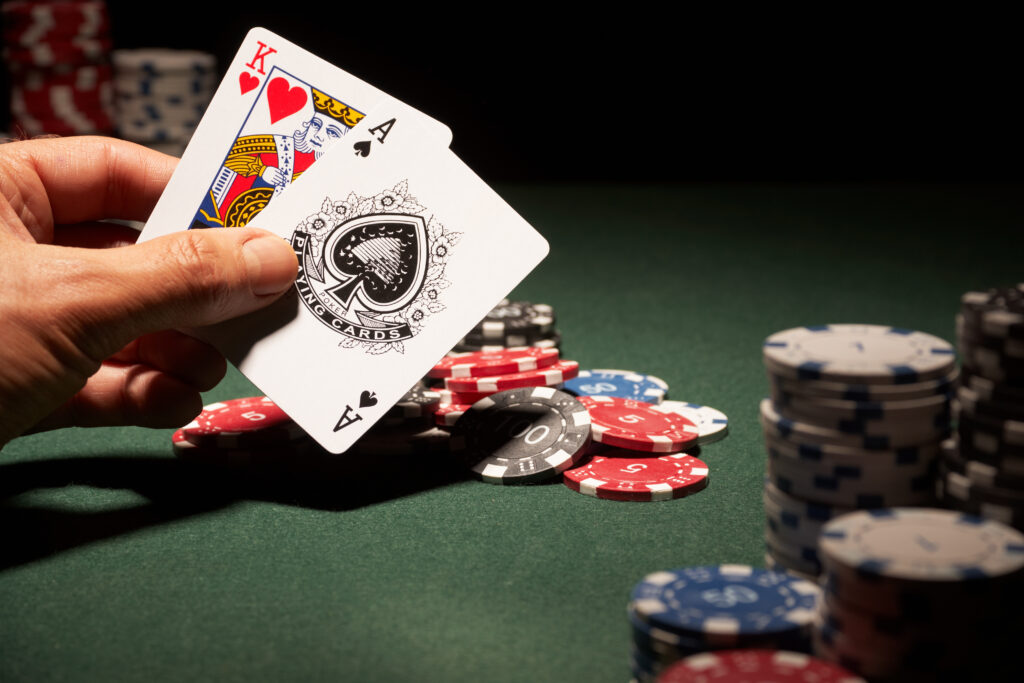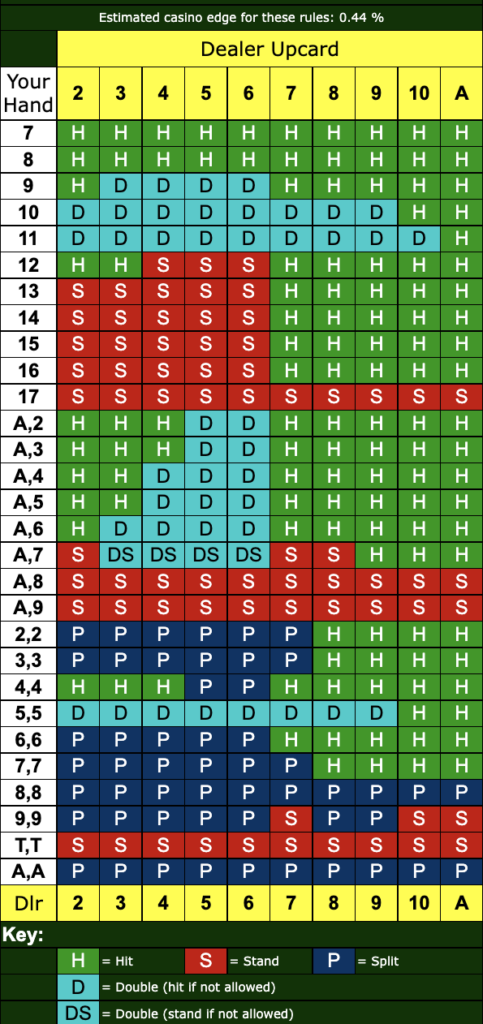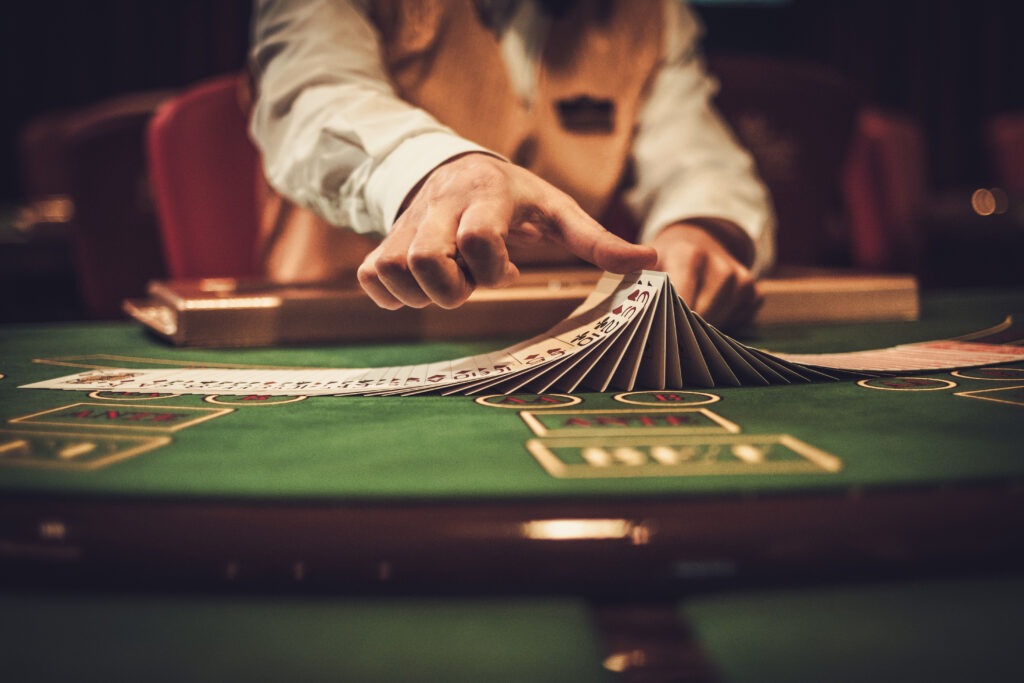Introduction
Blackjack is a game you can play at any casino, even in the comfort of your own home. It’s also the most popular card game in America, according to a survey conducted by the National Council on Problem Gambling (NCPG).
In blackjack, the player bets against the dealer. The object is to get as close to 21 as possible without going over. The rules of blackjack are simple: players bet on whether they’ll receive a higher or lower face value hand than their dealer. If they get it right, they win; if not, they lose or sometime a tie. It’s played by one or more players.
The dealer has an advantage in blackjack: he/she will get to keep his/her original hand after a deal, allowing the players to bust first (go over 21) and lose their bet before the dealer even shows and plays his/her hand. The house edge is around 1% but in most cases, it is more than that.
You can win at blackjack by playing smart and using strategy when betting. You can also win by getting lucky and hitting on a couple of hands!
Blackjack is a game of knowledge, skill and instinct but luck plays a big role on the outcome of the game.
Blackjack is a game of chance but it depends on how you play the game. In blackjack, you have to know what you’re doing in order to win. The more you play and practice, the better you get at it. The more knowledge and skill (and luck) that you have, the higher your chances of winning are. And while this may sound like common sense, it’s extremely important that all players of any casino game understand this concept before they start playing for real money.
So think about this before you start playing: What do I need to do? How can I improve my chances? What will help me learn faster so that I can win sooner?

Blackjack is one of the easiest card games to learn. All you need to do is beat the dealer’s hand total without going over 21.
That may sound difficult at first, but once you understand how blackjack works, it will become second nature.
Blackjack is played with a standard 52-card deck that has been shuffled by either an automatic shuffler or a live dealer. Depending on the table, it can be played with a single deck, a double deck, a shoe with 6 decks or a shoe with 8 decks. The cards are dealt into two hands: player and dealer. Each player gets two cards, typically face up while the dealer also gets two cards, one face down and one card face up.
The value of a hand is the sum of the point values of the individual cards.
A hand’s value is the sum of the point values of all its cards. Face cards (jack, queen, king) are worth 10 points. An ace can be counted as either 1 or 11. The value of a hand is simply the sum of the point counts of each card in the hand.
Hand totals range from 2 to 21; if you have cards that add up to 21 points or less, you’re still in the game and you have the chance of winning the hand. If not and you go over 21, then your hand is called bust and you lose your bet.

If you have an ace with a ten/face card, then it’s considered blackjack! You automatically win, given that the dealer doesn’t have a blackjack as well.
For example, if you have a ten and a five in your hand, the total value would be 15 points. A hand with an ace and a nine in it has a total value of 19 points, which is higher than 15 but lower than 21. An ace and a king is blackjack!
The most important rule of blackjack is simple: beat the dealer’s hand without going over 21. You draw cards until you reach your desired number and not busting. The dealer must hit (take more cards) until they reach 17 or higher; then they’ll stand on any total between 17 and 21.
If both you and the dealer have equal totals (for example, both you and the dealer got 18), it’s called a push; no money exchanges hands in this instance
Remember:
Face cards are worth 10 points.
An ace can be counted as either 1 or 11.
The value of a hand is simply the sum of the point counts of each card in the hand.
The moves
Doubling down allows you to double your initial bet in exchange for receiving only one more card. Doubling down is a common strategy that allows you to double your initial bet in exchange for receiving only one more card with the expectation of generating a hand that is good enough to beat the dealer’s hand. It is advisable that players only do this on hands no less than 10 and no more than 11. If playing a single deck of cards, it is desirable to double down on an 11 because it increases your chance of winning by 16%.
If you acquire two identical, you can add another hand by splitting them. Splitting pairs is when you have two cards of the same number, you can split them into two hands and make two new bets (one for each hand). In either case, each new hand will be played out separately.
Taking insurance. If the dealer has an ace showing and you think that the dealer’s other card is a 10 or face card (that will result to blackjack), you can pay half of your original bet to “insure” yourself against the dealer getting a blackjack; this means that if the dealer has another card that is equal to 10, you will not lose your bet. However, if the dealer’s card is 9 or below, you will lose the insurance money and the game continuous.
The basic strategy.

Most blackjack players follow the Basic strategy. Arguably, it is said to be the most effective way to play blackjack since it is based on the probabilities of cards being dealt. Edward O. Thorp introduced this in the 60s as a calculated method for winning at blackjack. Reprinted countless times, Thorp’s Blackjack Basic Strategy chart is a useful tool for knowing when to hit, stand, split, or double down.
In order to use basic strategy, you need to memorize a set of rules that tells you what to do in any situation. For example, if your first two cards are 7 and 4, you would hit because those two cards have a combined value of 11, giving you a good chance of improving the card without busting.
Here are some of the basic rules according to Thorp’s basic strategy:
- Never take insurance or “even money.”
- If surrender is allowed, surrender hard 16 (but not a pair of 8s) vs. dealer 9, 10, or A, and hard 15 vs. dealer 10.
- Always hit hard 11 or less.
- Stand on hard 12 against a dealer 4-6, otherwise hit.
- Stand on hard 13-16 against a dealer 2-6, otherwise hit.
- Always stand on hard 17 or more.
- Always hit soft 17 or less.
- Stand on soft 18 except hit against a dealer 9, 10, or A.
- Always stand on soft 19 or more.
Splits
- Always split aces and 8s.
- Never split 5s and 10s.
- Split 2s and 3s against a dealer 4-7, and against a 2 or 3 if DAS is allowed.
- Split 4s only if DAS is allowed and the dealer shows a 5 or 6.
- Split 6s against a dealer 3-6, and against a 2 if DAS is allowed.
- Split 7s against a dealer 2-7.
- Split 9s against a dealer 2-6 or 8-9.
Double
- Double hard 9 vs. dealer 3-6.
- Double hard 10 except against a dealer 10 or A.
- Double hard 11 except against a dealer A.
- Double soft 13 or 14 vs. dealer 5-6.
- Double soft 15 or 16 vs. dealer 4-6.
- Double soft 17 or 18 vs. dealer 3-6
Basic strategy can be used for both single-deck casinos and multiple-deck ones (which use two or more decks). It is a helpful guide specially for beginners but this strategy doesn’t guarantee winning. In my experience, deviating from this method at the right time is also rewarding. Sometimes, depending on the circumstances, strictly following this method can contribute to your loses. So trust your instinct.
Some rules vary from casino to casino, even on tables within the casino. This is why you should check with the dealer at your game for any variations on any of the rules listed here.
Some casinos may also allow you to hit (take more cards) after splitting aces while others don’t. You may also find casinos that will allow you to double down on your blackjack.
Also in some casinos, you can play multiple hands while others won’t allow you if you don’t have a player’s card. Other casinos will require you to double your bet if you want to play to hands or triple your bet if you want to play three hands.
When it comes to splitting in Blackjack, some casinos allow it and some don’t.
It is possible to split pairs. The dealer will then deal another card to each hand, so think carefully before splitting pairs. Splitting strategies vary from casino to casino so it’s important to check their rules before playing with them. For example, some casinos allow players only one split per round while others allow up to three splits depending on the size of the bet being made by the player at that time (the bigger their wager amount). Some casinos also limit how many times they can split while others do not!
Most casinos allow you to double down on any two-card hand with no restrictions.
You can make a second bet next to your original bet, wagering that you’ll get a great hand that will beat the dealer’s. Typically, players double down on their 10s or 11s in hopes that they will receive another 10 value card and will improve your hand (equivalent to 20 or 21). Remember, once you double down, you can only get one card.
You can double your bet, but only on two cards. In some casinos, you must have an ace or a hand that has a total of 10 or 11 to do so, but most will only let you do so with whatever value you have.
Conclusion
Blackjack is a great game for beginners because it’s easy to understand and can be as simple or complex as you want it to be. The most important thing is to remember the basic rules and keep your bet small until you get more comfortable with how the game works.
Bet responsibly, never gamble more than you can afford to lose. Learn when to leave.
Remember, you haven’t won until you take your profit and leave.

